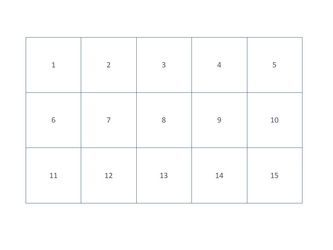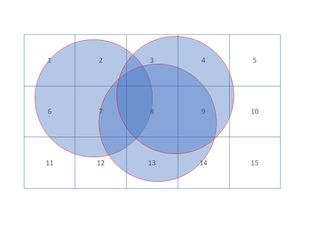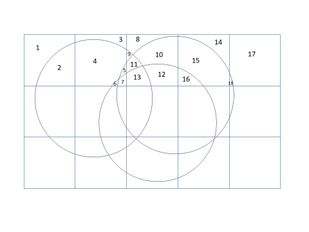Alteryx Designer Desktop Discussions
Find answers, ask questions, and share expertise about Alteryx Designer Desktop and Intelligence Suite.- Community
- :
- Community
- :
- Participate
- :
- Discussions
- :
- Designer Desktop
- :
- Alteryx spatial process: "cookie cutter" style pol...
Alteryx spatial process: "cookie cutter" style polygon slicing
- Subscribe to RSS Feed
- Mark Topic as New
- Mark Topic as Read
- Float this Topic for Current User
- Bookmark
- Subscribe
- Mute
- Printer Friendly Page
- Mark as New
- Bookmark
- Subscribe
- Mute
- Subscribe to RSS Feed
- Permalink
- Notify Moderator
Hi everyone
I've been struggling to find a way to do the following in Alteryx:
Given a set of contiguous polygons (input 1), I want to be able to cut each polygon into smaller sections wherever any polygon from a second set (input 2) overlaps it. Each resulting polygon would retain the data of the polygon it originally belonged to.
For further clarity, here is input 1 with 15 rows, each containing a shape:
Input 2 is brought in, containing 3 shapes . They sit on top of some of the shapes in Input 1. These 3 shapes, in turn, may or may not overlap each other.
Wherever the shapes of input 2 overlap with input 1, AND wherever one shape of input 2 overlaps another shape of input 2 and then also a shape of input 1, the input 1 shape is split in as many sub-polygons as necessary:
The output is a file similar to input 1 but now with 43 polygons as a result of the "cookie cutting" exercise (as partly illustrated above).
Each new polygon retains the data of its "parent". For example in the above picture, polygons 3,4,5,6,7 will all contain the same data that was originally in the polygon tagged "2" in the previous picture.
The "circle" (input 2) polygons contain no data and are there only for the purpose of slicing the polygons of input 1.
Is there a way of achieving this using Alteryx?
Looking forward to your suggestions!
: )
Solved! Go to Solution.
- Mark as New
- Bookmark
- Subscribe
- Mute
- Subscribe to RSS Feed
- Permalink
- Notify Moderator
For sure it's possible; I think it requires an iterative macro and it's not a straight forward problem! I thought I resolved it just now but I've found a minor problem which I'll look to fix. However i'm quite busy over the next few days.
Let's see if anyone jumps in but in the meantime I'll keep developing a macro that allows for this.
Ben
- Mark as New
- Bookmark
- Subscribe
- Mute
- Subscribe to RSS Feed
- Permalink
- Notify Moderator
Impressive - I think I've been underestimating this tool!
Thank you and I look forward to your suggestion. I'll try the iterative macro approach myself too.
Sergi
- Mark as New
- Bookmark
- Subscribe
- Mute
- Subscribe to RSS Feed
- Permalink
- Notify Moderator
@SergiArtigas Do you have any dummy data/polygons to play with?
- Mark as New
- Bookmark
- Subscribe
- Mute
- Subscribe to RSS Feed
- Permalink
- Notify Moderator
Are you wanting something similar to GIS Union? If so, here is a macro I created that takes two geographic inputs and overlays them to create intersecting polygons with attributes from inputs.
- Mark as New
- Bookmark
- Subscribe
- Mute
- Subscribe to RSS Feed
- Permalink
- Notify Moderator
@Patrick_digan Yes I do indeed, sorry it took so long to reply. The attached package contains a sample of shapes (the squares in my diagram) and target areas (the circles).
@Philip Thank you, I came across your solution in that thread and it does achieve what I need in principle, but I didn't know how to build a workflow that will take every shape in the file and cut the other file accordingly. That is, in a way that is repeatable no matter what number of "cutting shapes" your bring in.
- Mark as New
- Bookmark
- Subscribe
- Mute
- Subscribe to RSS Feed
- Permalink
- Notify Moderator
Attached is my attempt at it. I haven't checked out @Philip's macro.
I used a spatial match to get all the intersections. I then summarized that into 1 object and removed this from the original spatial objects. I've added a filter in there at one point in case you want to take out really small areas. I've currently turned it off by checking if 1=1, but you could remove the comments and turn it back on. You'll notice the last record at the very end has 8.04883526561763e-007 Sq Mi, which seems like noise more than anything.
- Mark as New
- Bookmark
- Subscribe
- Mute
- Subscribe to RSS Feed
- Permalink
- Notify Moderator
Thanks very much Patrick, I didn't think this could be done in such a straightforward workflow.
There's just one think I've tested and doesn't quite work with your setup - if the circle shapes in the "target area" file overlap each other (workflow attached showing this, for reference).
My best guess is that a similar procedure needs to be applied to the "target areas" file first, until each intersection is a separate polygon, and then make that the input of the workflow.
An iterative macro (where only 1 circle goes through your workflow each time) could be the solution, as I think @BenMoss was suggesting. I will try this approach and share it if I succeed.
- Mark as New
- Bookmark
- Subscribe
- Mute
- Subscribe to RSS Feed
- Permalink
- Notify Moderator
@SergiArtigas It looks like that is exactly what @Philip's macro is doing. It first finds any overlapping areas within each spatial set and then finds the intersections between the two sets. If his macro isn't a perfect fit for your situation, it would at least be a great starting point.
- Mark as New
- Bookmark
- Subscribe
- Mute
- Subscribe to RSS Feed
- Permalink
- Notify Moderator
You're right - I initially thought Philip's solution wouldn't work with just any number of shapes, but it does.
Thanks everyone for your help!
-
Academy
6 -
ADAPT
2 -
Adobe
204 -
Advent of Code
3 -
Alias Manager
77 -
Alteryx Copilot
24 -
Alteryx Designer
7 -
Alteryx Editions
90 -
Alteryx Practice
20 -
Amazon S3
149 -
AMP Engine
250 -
Announcement
1 -
API
1,207 -
App Builder
116 -
Apps
1,358 -
Assets | Wealth Management
1 -
Basic Creator
14 -
Batch Macro
1,552 -
Behavior Analysis
245 -
Best Practices
2,690 -
Bug
719 -
Bugs & Issues
1 -
Calgary
67 -
CASS
53 -
Chained App
267 -
Common Use Cases
3,820 -
Community
26 -
Computer Vision
85 -
Connectors
1,424 -
Conversation Starter
3 -
COVID-19
1 -
Custom Formula Function
1 -
Custom Tools
1,935 -
Data
1 -
Data Challenge
10 -
Data Investigation
3,485 -
Data Science
3 -
Database Connection
2,215 -
Datasets
5,215 -
Date Time
3,226 -
Demographic Analysis
186 -
Designer Cloud
737 -
Developer
4,360 -
Developer Tools
3,525 -
Documentation
526 -
Download
1,036 -
Dynamic Processing
2,934 -
Email
926 -
Engine
145 -
Enterprise (Edition)
1 -
Error Message
2,253 -
Events
196 -
Expression
1,867 -
Financial Services
1 -
Full Creator
2 -
Fun
2 -
Fuzzy Match
711 -
Gallery
666 -
GenAI Tools
2 -
General
2 -
Google Analytics
155 -
Help
4,703 -
In Database
965 -
Input
4,288 -
Installation
359 -
Interface Tools
1,899 -
Iterative Macro
1,091 -
Join
1,955 -
Licensing
251 -
Location Optimizer
60 -
Machine Learning
259 -
Macros
2,858 -
Marketo
12 -
Marketplace
23 -
MongoDB
82 -
Off-Topic
5 -
Optimization
750 -
Output
5,243 -
Parse
2,325 -
Power BI
227 -
Predictive Analysis
936 -
Preparation
5,159 -
Prescriptive Analytics
205 -
Professional (Edition)
4 -
Publish
257 -
Python
851 -
Qlik
39 -
Question
1 -
Questions
2 -
R Tool
476 -
Regex
2,339 -
Reporting
2,428 -
Resource
1 -
Run Command
572 -
Salesforce
276 -
Scheduler
410 -
Search Feedback
3 -
Server
628 -
Settings
932 -
Setup & Configuration
3 -
Sharepoint
624 -
Spatial Analysis
599 -
Starter (Edition)
1 -
Tableau
512 -
Tax & Audit
1 -
Text Mining
468 -
Thursday Thought
4 -
Time Series
430 -
Tips and Tricks
4,183 -
Topic of Interest
1,125 -
Transformation
3,720 -
Twitter
23 -
Udacity
84 -
Updates
1 -
Viewer
3 -
Workflow
9,962
- « Previous
- Next »





